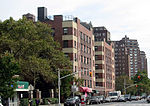Nechtanc
Former Native American populated places in the United StatesHistory of ManhattanLenapeMassacres of Native AmericansNew Netherland

Nechtanc ("sandy point") was a Lenape settlement of the Canarsee located in what is now Two Bridges, Manhattan or the Lower East Side where the East River begins to turn north. In 1643, the settlement was the site of a massacre of Lenape people, mostly women and children, after the governor of New Netherland ordered the people killed as they slept. A simultaneous massacre occurred at Pavonia, just across the East River. The village is alternatively referred to in historical documents as Rechtauk.
Excerpt from the Wikipedia article Nechtanc (License: CC BY-SA 3.0, Authors, Images).Nechtanc
Lewis Street, New York Manhattan
Geographical coordinates (GPS) Address Nearby Places Show on map
Geographical coordinates (GPS)
| Latitude | Longitude |
|---|---|
| N 40.715 ° | E -73.979 ° |
Address
East River Cooperative Power House
Lewis Street 26
10002 New York, Manhattan
New York, United States
Open on Google Maps






